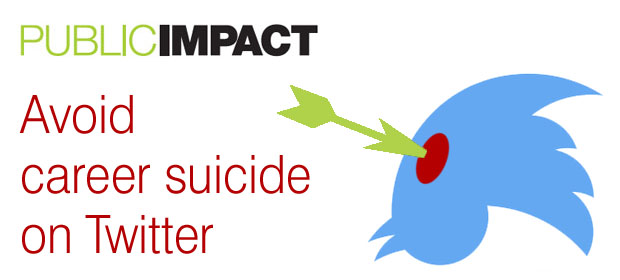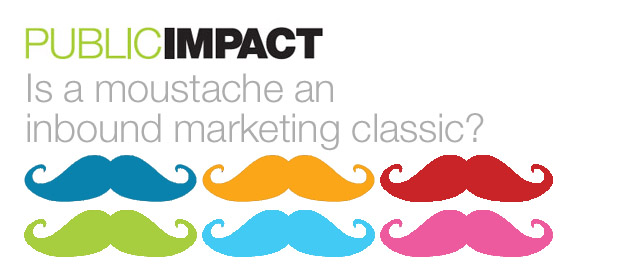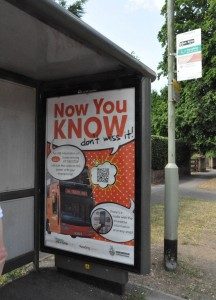Twitter, for a communication channel that has been around for less than a decade, has an impressive record of bringing political careers to a premature close and it has done for a few business leaders too. Reputation management is key for not-for-profit and for commercial business yet we have found all kinds of organisations that fail to even consider the potential risks in a badly managed approach to social media and Twitter in particular. You can read quite a few things about making the most of Twitter and a few on the downside, most of which are common sense. So why does common sense so frequently deserts otherwise intelligent people on Twitter? What are the most common mistakes with Twitter in not for profit.
Why Is Twitter Especially Lethal?
Twitter is the most deadly of the social networks. It is still leading edge, immediate, has massive reach and, because it is limited to 140 characters, is prone to ambiguity:
Leading Edge: The leading edge has always been high risk as well as potentially rewarding. However many people profess to be experts this is still a developing medium and is still new to a lot of people. People will pretend to ‘know’ because they don’t want to appear ‘uncool’ or ‘out of date’ and will bluff when they should take the time to learn. Do you really want to be the one tweeting “LOL” thinking it means ‘lots of love’? Who was that again?
Immediate: The instant nature of Twitter is also it’s biggest single risk. We live in a 24 hour news culture when there is a perceived value in being first, or at least fast. Twitter is quick, easy and mobile. Too easy – too easy to comment without checking facts, too easy to spout glib platitudes just to be seen and far too easy to comment without engaging the brain. And this is the Internet – once you’ve said it, chances are it will be there forever. Tweet in haste, regret at your leisure – so question whether speed is really so important. If the subject really matters it will still be around next morning. Think twice. Sleep on it.
Ambiguity: 140 characters isn’t an ideal length for engaging in complex debate! The need to get your point into a tweet can sometimes limit the clarity of a comment. So take care before you tweet to mean what you say and say what you mean – if in doubt phone a friend.
Reach: It’s amazing that some people treat a conversation on social media they way they would speak to their friends in the pub seeming without any concept that the world is watching – or could be. Worse, people seem to think they are talking with just their friends – you’re not, and you’re not when you’re on Facebook either. Just as you shouldn’t write anything on a blog that you won’t want to stand by or at least justify five years hence. And just as you shouldn’t say anything to a journalist that you wouldn’t want to stand by in print you shouldn’t say or share anything online that you wouldn’t want the world to know or see. It’s the internet – there is no private.
How to avoid the most common mistakes with Twitter in not for Profit
So Twitter is a high risk medium, but applying a little common sense will keep your career intact. Avoid these most common mistakes with Twitter in not for profit.
New media, same old law.
Twitter is publishing – a one to many medium – so the laws of libel apply. Sally Bercow, an upcoming celebrity and aspiring politician, forgot that and subsequently lost in court. She wasn’t the first and she won’t be the last. So be careful what you say about people and ask yourself if it is really worth it or helps the cause. Understand also that re:tweeting a libellous tweet is compounding a libel and also actionable.
Drunk in charge of an iPhone.
Using Twitter in a chemically altered state is a thoroughly bad idea, but it’s easy, so it happens. Be professional, make it a rule and just don’t go there.
“We don’t get it but that’s OK because the intern does”
It’s amazing how often I’ve heard this. The CEO is too old (for which read lazy) to bother with social networks, the Marketing Manager is too embarrassed to admit their knowledge is scant but the intern is under 25 so they must just know! Or something like that, so the unmanaged intern gets the job of running the Twitter feed. Ask yourself a serious question – would you put the intern on TV for the organisation? No, thought not! So is Twitter really important to you? If it is then start with a strategy, make sure senior management understand their role in the strategy and if you do involve the intern make sure they are managed.
Criticising the audience.
The difficulties of a the British politician, Emily Thornbury, prompted this blog. She committed the cardinal sin for a politician of appearing to criticise the voters and resigned. The commercial equivalent is criticising the customers, appearing to treat them with contempt, or in not for profit the members or supporters. It happens and it’s lethal. Think about how others may interpret your words.
Things aren’t always what they seem.
It’s the Internet. People are not always who they say they are. The link that you are about to retweet might not lead to what you think it might – so unless you are sure of your source it’s best to check. You don’t have to be a conniving journalist to set someone up on the web – and if you think you have no enemies, think again. There is always somebody with a problem with your company or cause. This is the internet; if they’ve an axe to grind they will be out there in cyberspace.
You are the brand
Sorry to say it but your never off duty. If you have your organisation’s name or Twitter handle in your profile you are representing them, like it or not. Maybe not formally, maybe not legally, maybe not officially but the audience will judge the organisation by its people.
Inappropriate jokes will offend – there’s always one.
Humour can backfire. What works in the bar doesn’t necessarily work online. So be careful with jokes – especially topical jokes about serious vents involving human beings. It might be darkly funny, but it’s usually better to think twice and be boring. Remember outrage is the norm on the web.
Avoid contempt
Contempt for the audience is lethal. Contempt of Court can involve jail and is to be avoided. Even if it is unlikely that you’ll be dragged before The Beak, commenting on matters currently before the courts doesn’t suggest you are trustworthy. It doesn’t matter if the subject is central to your mission or if it is a matter of major concern to your members – you just can’t talk about cases currently before the Courts. Even high ranking public figures seem to struggle with this simple concept.
Is it yours to share?
The internet has changed the world, but it hasn’t change the law on copyright. If you are going to share content then you need to know the owner is happy to do so, properly credited. Images carry ownership and rights – so be careful not to expose your organisation to a rights suit.
Good manners don’t hurt
Getting involved in a debate is one thing – and it’s in the nature of the medium. But keep it professional and don’t get drawn into abuse – leave that to others and if it starts disengage. It’s one of the remarkable things of the medium that some individuals are prepared to say things in public to and about people they have never met that they would never dream of saying in person. Remember, you are the brand.
Don’t be put off
Just stick to eight basic principles:
- Be sensitive – don’t use a crisis or a tragedy to make a point
- Stay positive – play your own game and don’t be personal
- Be literate – check the language you use – and beware of predictive text! If your not sure then get someone to check.
- Be factual and truthful – check facts, check sources and don’t mislead
- Keep it clean – stay away from content that might offend – it might be harmless but not everyone is as open minded as you are – you have nothing to gain
- Be clear – say what you mean, mean what you say, avoid ambiguity. (If you need to make a longer statement on Twitter try using TwitLonger – it’s a great little tool)
- Only when sober – know your limits, don’t drink and tweet!
- Plan ahead, be strategic – that way your tweets are considered and thought out
Follow these principles and you should be fine. As for the dark side of social media, follow the principle that performing at your best sometimes means planning for the worst.



 Wokingham Borough Council commissioned Public Impact, which has a strong track record in a number of
Wokingham Borough Council commissioned Public Impact, which has a strong track record in a number of